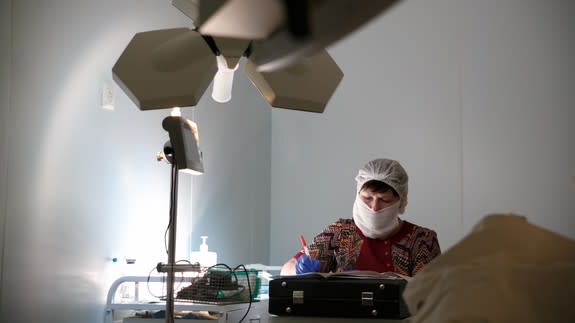A robotic implant that hugs your heart could help it keep beating

A soft robotic sleeve made of silicone could help a human heart keep beating, according to a new report published Wednesday.
For the millions suffering from heart failure and other cardiac issues, that could mean a beating heart without the blood clotting complications of the current mechanical heart pumps called ventricular assist devices, or VADs, according to a statement from the National University of Ireland Galway.
The research, published in the journal Science Translational Medicine, was led by Ellen Roche of that university. It took place at Harvard and at Boston Children's Hospital.
SEE ALSO: This Albert Einstein robot can help you learn science
Made of soft fibers including silicone, the robotic sleeve bonds itself to the heart by wrapping around it, essentially becoming part of the beating organ as it moves in synch with it.
In doing this, it provides circulatory support for hearts not functioning properly, supporting blood flow through a sleeve that manages to not come in contact with blood, as explained in the study.
This design marks a departure from the way VADs support heart function, as those devices must interfere with blood flow in order to assist in healthy pumping of the heart.
"Using current VADs, the heart and one or both of the great vessels are cannulated, blood is removed from the heart, and blood is then pumped into the aorta or pulmonary artery," the researchers write. "In this scenario, the VAD assumes the function of one or both of the failing ventricles of the heart."
But clotting complications that can require potentially risky blood thinners make VADs a less than ideal solution for those suffering heart failure.

Image: American Association for the Advancement of Science
Researchers tested out the new robotic sleeve using a pig heart to examine how effectively it supports heart function.
"The soft robotic sleeve we describe took inspiration from native heart muscle and was designed to augment cardiac function by closely replicating it, instead of disrupting it," the researchers wrote.
In this way, soft robotic techniques were used to "replicate the heart’s motion."
The study explains that the broader field of robotics is facing new developments as softer materials are being used in innovative new ways.
"However, the field is being transformed by a new wave of soft robots that are constructed using a combination of elastomers, fibers, and other filler materials," the study explains. "This approach provides opportunities to create robots that are well suited for intimate interactions with humans and with tunable material properties to match biological tissues."
Such designs in medical robots can provide patients with more options, such as with the sleeve that wraps around the heart.
"The sleeve can be customized for each patient," Dr. Roche said in the statement. The parts of the heart involved, and the strength of the pressure the sleeve uses, can be adjusted according to a patient's individual case.
Robots have been used for a lot of things, from being a personal writing machine to delivering food to your doorstep, but helping a person's heart pump makes them even more useful.

 Yahoo News
Yahoo News 